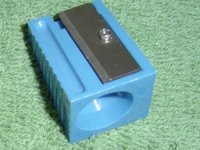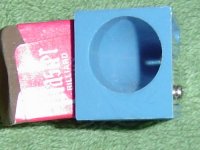Okay. To start the process, get yourself a razor blade, preferably a titanium one. If using a regular blade, press the tip into a cutting surface, so the shaft is standing upright, vertically. With great care, cut the overhang from the tip, all the way around. Pay attention to not angle the blade, but concentrate on cutting straight down.
If using a titanium blade, you can do the same thing or, if you have steady hands, simply lay the blade flat against the ferrule (you should be sitting down, holding the shaft horizontally) and swipe the blade away from the shaft to cut away the excess leather. Get a good feel to how much pressure is needed to cut through your particular tip.
Now that you've trimmed away most of the excess leather, it's time to make it perfect. The goal here is to remove leather ONLY, and not nick, scratch, or f-up in any way that pristine white ferrule.
You will need a range of sandpaper, from 300-800, a magazine, scotch tape, and some sort of stopper for the tip.
On a flat surface, lay your shaft down with the joint end supported by a magazine. Tape up your ferrule with a piece of scotch tape, right to the edge of the tip. This is added insurance. Draw a dot on the tape; this will guide you around the sanding process.
Place your tip on the piece of rough sandpaper, with only the tip resting on the edge of the sandpaper. Move the stopper (I use a cd case) until it is pressed against the top of the tip. At this point you can either carefully turn the sandpaper/stopper unit over and tape it, or just press down firmly on the stopper.
There should only be a strip of sanding surface exposed, the width of your tip height.
Now, with the dot you drew on the tape facing upwards, slowly grind the tip back and forth on the sandpaper, with gentle pressure towards the stopper. Start with 2-3 passes, then rotate the tip a fraction of an inch, and keep sanding thusly until you see the dot pointing upwards again.
**make sure the stopper has not moved, you don't want to scratch the ferrule!**
Inspect the tip, and see how much more you have to sand. Also, look for raised bumps in the sidewall and take care of those first. If the first pass took off a lot of leather, move onto the finer grade sandpaper. If not, repeat with coarser paper.
When the tip is trimmed to your satisfaction, burnish the sidewall. I use a rough piece of leather and spit. Shape the tip to the desired radius, and you should be good to go.
Here's a pic of the sandpaper trimming gadget that I just snapped off now. All of this I gleaned from this very site, I forgot who described the sandpaper jig but the titanium blade was suggested by JoeyinCali, and that was a great help.
Good luck,
Roger
*That, btw, is the new T O O L album...the greatest band in the universe!*

